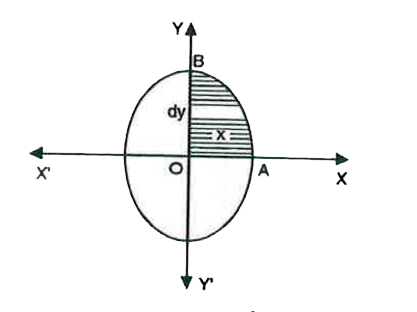Find the area of the smaller region bounded by the ellipse x29+y24=1 and the line x3+y2=1
To find the area of the smaller region bounded by the ellipse x29+y24=1 and the line x3+y2=1, we will follow these steps:
Step 1: Identify the parameters of the ellipse
The given ellipse is in the standard form x2a2+y2b2=1, where a2=9 and b2=4. Thus, we have:
- a=3
- b=2
Step 2: Calculate the area of the ellipse
The area A of an ellipse is given by the formula:
A=πab
Substituting the values of a and b:
A=π⋅3⋅2=6π
Step 3: Find the area of the triangle formed by the line and the axes
The line x3+y2=1 can be rewritten in intercept form:
- The x-intercept occurs when y=0:
x3=1⟹x=3
- The y-intercept occurs when x=0:
y2=1⟹y=2
Thus, the triangle formed by the line and the axes has vertices at (0,0), (3,0), and (0,2).
Step 4: Calculate the area of the triangle
The area At of a triangle is given by:
At=12×base×height
Here, the base is 3 and the height is 2:
At=12×3×2=3
Step 5: Calculate the area of the smaller region
The area of the smaller region bounded by the ellipse and the line can be found by subtracting the area of the triangle from the area of the quadrant of the ellipse. The area of the quadrant of the ellipse is:
Area of quadrant=14×6π=3π2
Thus, the area of the smaller region As is:
As=Area of quadrant−Area of triangle=3π2−3
Final Answer
The area of the smaller region bounded by the ellipse and the line is:
As=3π2−3
The given ellipse is in the standard form x2a2+y2b2=1, where a2=9 and b2=4. Thus, we have:
- a=3
- b=2
The area A of an ellipse is given by the formula:
A=πab
Substituting the values of a and b:
A=π⋅3⋅2=6π
The line x3+y2=1 can be rewritten in intercept form:
- The x-intercept occurs when y=0:
x3=1⟹x=3
- The y-intercept occurs when x=0:
y2=1⟹y=2
Thus, the triangle formed by the line and the axes has vertices at (0,0), (3,0), and (0,2).
The area At of a triangle is given by:
At=12×base×height
Here, the base is 3 and the height is 2:
At=12×3×2=3
The area of the smaller region bounded by the ellipse and the line can be found by subtracting the area of the triangle from the area of the quadrant of the ellipse. The area of the quadrant of the ellipse is:
Area of quadrant=14×6π=3π2
Thus, the area of the smaller region As is:
As=Area of quadrant−Area of triangle=3π2−3
The area of the smaller region bounded by the ellipse and the line is:
As=3π2−3
Similar Questions
Knowledge Check
- Question 1 - Select One
Find the area of the region bounded by the ellipse x24+y29=1.
 A10πB11πC12πD13π
A10πB11πC12πD13π - Question 2 - Select One
Find the area of the region bounded by the ellipse x29+y24=1 in fourth quadrant.
A3π4 sq unitsB3π2 sq unitsC5π2 sq unitsDNone of these - Question 3 - Select One
The area of the smaller region bounded by the circle x2+y2=1 and the lines |y|=x+1 is
A(π−2)/4B(π−2)/2C(π+2)/2DNone of these
Find the area of the smaller region bounded by the ellipse x2a2+y2b2=1and the line xa+yb=1
View SolutionUsing definite integration, find the area of the smaller region bounded by the ellipse 9x2+16y2=144andx=2.
View SolutionFind the area of the region bounded by the ellipse x2a2+y2b2=1
View SolutionFind the area of the region bounded by the ellipse x29+y24=1 in fourth quadrant.
View SolutionThe area bounded by the ellipse x24+y225=1 is
View Solution

